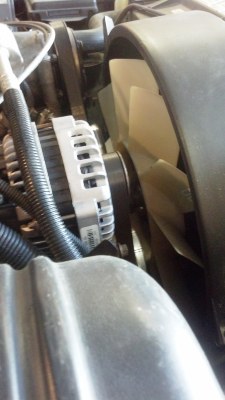The Best Guide To Fan Blades
Table of ContentsThe Ultimate Guide To Fan BladesSome Ideas on Fan Blades You Should KnowUnknown Facts About Fan Blades
Non-thermal clutches operate entirely based on the shaft speed of the water pump. At low and idling speeds, the clutch enables the fan blade to turn at practically a 1:1 ratio. At high speeds, the silicone fluid within in the clutch will lose its capability to move the energy from the shaft to the fan clutch body (and for that reason, the fan) and the fan is then enabled to nearly free-wheel, eliminating its load from the engine.However, non-thermal clutches are a lower-cost choice than thermal-style clutches. The thermal fan clutch runs in action to underhood temperature levels. As hot air blows across the radiator, it heats a thermal spring mounted at the front of the clutch. As the spring is heated, it turns and enables valve ports to open within the clutch.
This engages the clutch and drives the fan. Once the engine is cooled down, the thermal spring rotates back and closes the valve ports, disengaging the fan. The speed at which a thermal fan clutch spins a fan depends mostly on the specific fan you select. On the Summit Racing website, for example, you'll discover 3 various types of thermal fan clutches from Hayden alone: This design turns the fan at 60-70 percent of the water pump shaft speed when engaged, and 20-30 percent when disengaged.
This fan style turns the fan at 70-90 percent of the shaft speed when engaged for increased cooling. When disengaged, it turns the fan at 25-35 percent. It's used with deeper-pitch fans (2Â 1/2 of pitch), and works well with greater operating rpm. Extreme duty thermal fans turn the fan at 80-90 percent of the shaft speed when engaged and 20-30 percent when disengaged.
This style of fan clutch runs like a thermal clutch, however the ECM/PCM signal manages the level of engagement of the EV clutch. This engagement process is ultimately managed through the ECM/PCM by the following input variables: Coolant Temperature level, Consumption Manifold Temperature, Transmission Oil Temperature Level, A/C Pressure and Engine Oil Temperature Level.
Like all elements, fan clutches will wear and require changed. fan blades. According to Hayden, here are some indications your fan clutch might require changed: Fan spins excessively when engine is stopped (3 or more times when hot engine is shut off). Poor A/C performance at idle or low car speeds.
Fan Blades - The Facts
Fan speed does not increase up until engine is exceedingly hot. Fan blade click this site pointer moves more than 1/4-inch front to back. Fan turns roughly or does not turn at all. Extreme fan sound at all speeds due to unsuccessful bearing. Vibration that increases with engine speed. Leaking fluid or oily develop around the bearing or thermal spring.
289, 302, W/ FAN CLUTCH MANAGER 302, W/ FAN CLUTCH 250, W/ FAN CLUTCH W/ FAN CLUTCH, REPLACEMENT 289, FACTORY A/C AND FAN CLUTCH 289, DELUXE DEALER A/C 200, FACTORY A/C, POWER FAN, W/O EMISSIONS FAIRLANE, TORINO, 200, A/C, POWER FAN, W/ EMISSIONS: This product can expose you to chemicals including lead and DEHP, which are understood to the State of California to cause cancer and birth defects or other reproductive damage.

Almost unprecedented on modern cars with electrical engine cooling fans, individuals in some cases still refer to the accessory drive belts as "fan belts." This term harkens to the day when vehicles and trucks utilized drive belts to drive the cooling a knockout post fan or water pump. The engine cooling fan, made from plastic or metal, isn't hard-connected to the fan pulley or water pump, however instead is soft-connected by means of the fan clutch.
A stopping working fan clutch could leave you stranded with costly repair work costs, so take notice of these symptoms. Here, you can see where the fan and fan clutch are driven by the engine (fan blades). Morio/ Wikimedia Commons There are three kinds of fan clutch, depending upon the car's design. A percentage of resistance constantly keeps the fan spinning, however it's essentially free-wheeling up until the fan clutch engages.

Some Known Facts About Fan Blades.
A centrifugal valve opens to enable the flow of heavy silicone fluid, locking the fan blades to the wheel. At idle and low engine speeds, this fan clutch is completely engaged, gradually disengaging as engine speed increases. Depending upon the application, it might freewheel above 2,500 to 3,000 rpm. An functions similar to thermal and torque-limiting types but isn't modulated directly by temperature level or speed.
If the fan clutch is spoiling or has stopped working, there are a couple of ways you might notice. Taking note of your car is the very first action in an accurate medical diagnosis, efficient repair, and reliable automobile. at low speed or when stopped is the most-common fan clutch failure symptom.
At a stop, however, due to the fact that the fan clutch doesn't engage and air isn't forced through the radiator, the engine can't dissipate excess heat. in winter season is another typical problem however triggered basics by the opposite fan clutch failure. If the fan clutch seizes, it stays engaged all the time, cooling off the engine excessive.
This can trigger bearing damage, radiator damage if the blades bend too far, or perhaps shatter a plastic fan. after engine shut-down may suggest a weak clutch. Silicone fluid leaking from the fan clutch would trigger this issue. When the engine is off, there are a couple of things you can do to check the fan clutch:. fan blades.